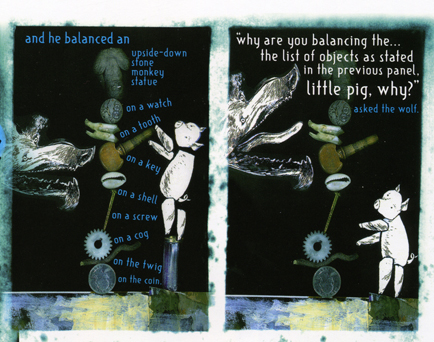Note: Steve Bissette and I are teaching a course in contemporary comics history (Survey of the Drawn Story II, as it’s properly known). Our students are required to submit an essay, in blog form, on an aspect of contemporary comics history. They are restricted to the period of 1969 – present.
Today’s essay is by Andrew James Christensen. Enjoy!
– Robyn Chapman
Dave McKean’s Pictures That Tick
By Andrew James Christensen
Pictures That Tick is a fantastic collection of Dave McKean’s personal comics work. The pages are filled with his explorations and experimentations in writing, drawing, painting, photocopying, photography, and probably a dozen other processes McKean tampers with, all united under the common theme of story-telling.
In general, all of his stories are dreams, poems, fairy-tales, and music. Some contain more of those elements than others, but they all fall in that spectrum. Part of this is certainly due to the words he chooses to tell his stories, but I expect that this notion is more due his visual choices.
One thing I love about Dave McKean’s work is that nothing is off-limits. Anything that can be used as a means to make pictures can and will be used. Pictures That Tick provides many examples of this notion. In particular, a single page story entitled “Liam’s Story” is a product of playing with a color copier (as McKean explains in a brief introduction). The story itself is about a pig stacking objects upon one other until he wants to “huff and puff” and blow them over. Only he discovers they won’t fall because they are not being stacked up from the ground but instead flat along the glass of a photocopier.
Besides the photo-collage work that has become a staple of McKean’s imagery, I was excited to see a good amount of his straightforward work with ink. Be it by pen or brush, I feel that the ability to make pictures out of simple lines is evidence of a great cartoonist/illustrator. It’s like a magician having to perform without all the smoke and mirrors, and instead being limited to a deck of cards or just a coin. Don’t get me wrong, the “smoke and mirrors” are really cool and all, but if that magician can amaze you with the basics, then you know they’ve got something special. AND, it makes the “showy” stuff all the more believable. Not that I ever doubted McKean’s artistic expertise, seeing his work with ink confirms his mastery of the visual medium. Two stories in this collection really highlight this: “Bitten and Bruised” and “(eye)” (literally, the title is a symbol of an eye). “(eye)” in particular is a visual masterpiece. Basically, it is about a bird soaring over a town and various moments of peoples’ lives within it. The pages are commonly formatted into three panoramic panels, which is perfect for depicting the bird’s journey. This story, as with many of the stories in the book, becomes very rhythmic due to the regular page division.
My absolute favorite two stories in this collection, “Mixed Metaphors” and “Black Water”, combine both ink linework and McKean’s digital-collage method for color and/or background. However, “collage” may be an incorrect description in these stories’ cases, as it’s more a matter of overlaying textures and possibly digital blending (who knows the process but McKean). “Mixed Metaphors” is another wordless story that is beautifully composed and tinted with sepia-toned textures. The story is simple, enigmatic, and beautiful. “Black Water” may be my favorite story of all, but I’d expect that’s due to a bias love of painting on my part. Unfortunately, I often find that in “painted comics” the artwork actually distracts from the story itself, and thus ceases to be as much a comic as a series of paintings in comics-form. This is not the case in “Black Water”. Here paint seems to be used simply as another tool in a cartoonist’s toolbox. By this I mean that McKean manages to use painting seamlessly within the “comics” framework, combining it beautifully with brushed inks and perhaps some digital manipulation. Besides the visuals, the story is also a simple dreamlike anecdote for returning to a place that might be better left alone.
Pictures That Tick may not be for everyone. It certainly takes a willingness to participate in the dreamlike wanderings of Dave McKean’s mind. But whether willing or not, it’s clear from this book that the comics medium has so much to offer. The only limitation is that we have to bring ourselves to put pictures to paper and make it exist.
– Andrew James Christensen





